Why do you need a well water test and how to do it
Many experts do not recommend using water from a well for food until its analysis is completed. The fact is that even well water, contrary to the general opinion of its purity, can be harmful to health. Therefore, below we will consider how and where it is possible to make a water analysis from a well, and also why it is needed at all.
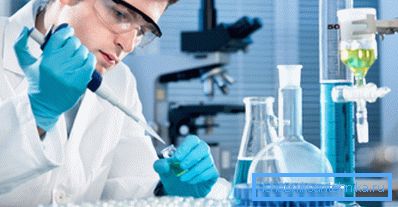
General information
First of all, you should consider what kind of water can be obtained for drinking, since the aquifers are located at different depths and the water quality in them is different. So, the first aquifer is located closest to the soil surface. However, most often the water in it is generally not suitable for drinking, as it contains many harmful substances and impurities that penetrate from the surface of the earth. (See also the article How to clean a well: features.)
Therefore, the quality of the first aquifer is largely influenced by the soil itself, or rather, its ability to trap harmful substances. To know this, you can only perform a water analysis in the well.
Water located between impermeable layers is much more qualitative, since there is practically no access to it from outside for contaminants. Therefore, wells, as a rule, dig up to the first interstratal horizon. True depth of its occurrence may be different and pre-predict it is almost impossible.
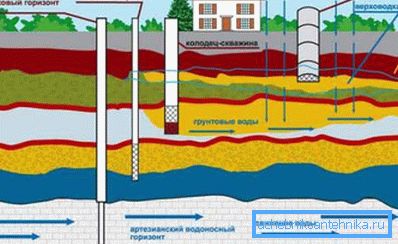
Therefore, before digging a well, it is necessary to carry out reconnaissance drilling, or at least ask about the depth of the waters of the neighbors. As a rule, the well is not dug deeper than 10–15 meters, since it is much more expedient to complete the well. However, in this case there is no guarantee of water quality, therefore, the analysis of such water is required to no less a degree.
More often than not, the water obtained from the second aquifer is of higher quality, but it is located very deeply - up to 200 meters and even more. Therefore, to dig a well of such a depth is simply unrealistic. Even to perform the well with your own hands to the second aquifer without special equipment is unlikely to succeed.
Why do you need analysis
So, as we found out, water from wells is mined in the uppermost aquifers, which are most susceptible to pollution. Therefore, if your site is located in an ecologically clean area, it does not guarantee that the water in the well is of sufficient quality so that it can be used as drinking water.
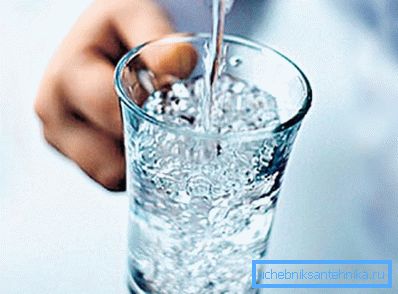
Note! If the well was recently dug, it is not recommended to use water from it, even for economic purposes, without first performing the analysis. This is due to the fact that a large amount of impurities can lead to the failure of household appliances.
Immediately it should be said that water analyzes from the well are of two types:
- Chemical;
- Bacteriological analysis.
Now let's take a closer look at why we need each of them.

Chemical
The analysis of this type involves the study of the physicochemical properties of the liquid, in particular, it allows you to determine the content:
- Gland;
- Manganese
- Sulphates;
- Ammonium;
- Mercury;
- Copper;
- Lead;
- Cadmium;
- Pesticides;
- Herbicides;
- Insecticides;
- Pesticides;
- Herbicides;
- Insecticides with their various derivatives;
- Hydrocarbons;
- Vinyl chloride;
- Dioxin and other elements.
Another crucial point is to determine the content:
- Alpha particles;
- Radium
In addition, chemical analysis allows to determine:
- PH;
- Turbidity;
- Alkalinity;
- Rigidity.
As you can see, some of the elements that may be contained in the water, when ingested, can cause serious harm to health. Therefore, well water should be studied especially carefully.
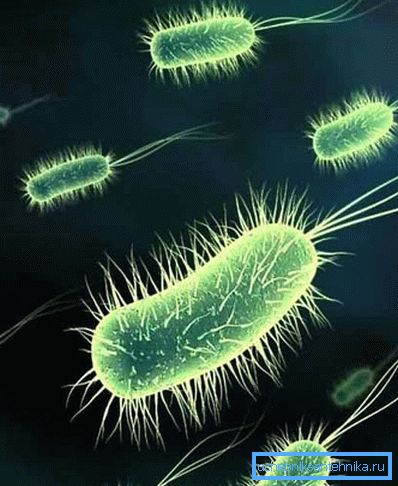
Bacterial
Bacteriological water analysis provides information on the composition and number of bacteria in the liquid.
Including such microorganisms that are dangerous to humans, such as:
- E. coli;
- Cholera;
- Typhus;
- Dysentery and many others.
How to take water for analysis
To ensure that the results of the study are objective, water from the well is taken for analysis according to certain rules. If they are not followed, then it is almost impossible to find out the real picture of the composition of the liquid, which means that the money for this procedure will be wasted.

When to take water for analysis
Immediately I must say that you should not perform water analysis, immediately after the well was dug. For the objectivity of the result, the source should be actively exploited for several weeks, naturally, without using water for food purposes.
During this time, cement solution will be washed from the well, which is used to seal the seams of the column, lubricate water-extracting equipment and other elements that are temporarily present in the water.
Note! Before performing laboratory analysis, it is necessary to treat the well with sodium hypochlorite solution. Antibacterial treatment is performed for 12 hours, after which the water from the source is pumped out over several days.
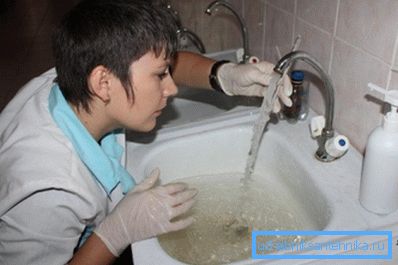
Water extraction for chemical analysis
To perform a chemical analysis, it is advisable to collect water in glass or plastic containers. As a rule, 2-4 liters will be quite enough. But, most importantly, the container was clean and did not have any extraneous odors.
Therefore, it is impossible to use the container, which previously contained sweet drinks, beer, technical liquids, etc. In addition, the container should not be washed using detergents. The best option is to buy a bottle of mineral water (non-carbonated) and open it just before the liquid intake.
Considering the cost of the analysis, it is necessary to strictly observe the rules of water intake, since it can be costly to re-perform it.
So, the selection instruction is as follows:
- If the water is lifted by the pump, then before you fill the tank, it must be drained within 10-15 minutes.
- After that, the container with the lid must be rinsed with the water that is taken for analysis.
- Then it is necessary to pour a thin stream of water into the container under the very neck and tightly close the lid.
- After that, materials for analysis should be delivered to the laboratory as soon as possible, and no later than 2 hours later. The faster the analysis will be carried out, the more reliable the results will be. It should also be borne in mind that during transportation, the sun's rays should not fall on the water, because when interacting with them, chemical reactions take place in liquids.
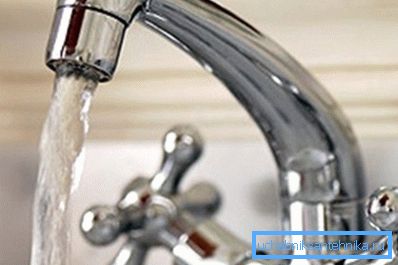
Water extraction for bacteriological analysis
When water is taken for bacteriological analysis, it is necessary to minimize the possibility of bacteria entering the liquid from outside. For this reason, the operation must be performed very carefully and quickly. Naturally, the container must be sterile.
It is best to take the container in advance in the laboratory in which the analysis will be performed. In addition, it is very important to produce antibacterial treatment of the well before the fence. Even if it is no longer a new one and a similar operation was once carried out, it should be repeated again before drawing water.
If water is drawn from a tap or hose, then it must first be thoroughly wiped with medical alcohol. In addition, the water before the fence should be drained for 15-20 minutes. The procedure must be performed in medical gloves, trying not to touch the neck with your hands. (See also the article Water Well Filter: Features.)
Where can I analyze
Now it remains only to figure out where to make the analysis. Actually, the choice is not great - either in the nearest state-owned SES, or in a private laboratory, if there is one nearby. I must say that the price of services in a private laboratory may be higher, however, the range of services is usually broader.
Therefore, it is advisable to find out in advance all possible options. In this case, you should agree at what time you will take water for research.
Conclusion
As we found out, water analysis is a necessary operation, otherwise it is possible to cause irreversible harm to health with drinking water, even if the liquid was heat treated before use. At the same time, it is extremely important to correctly perform the intake of water, in accordance with the rules given above, in order to obtain reliable results.
Additional information on this topic can be obtained from the video in this article.